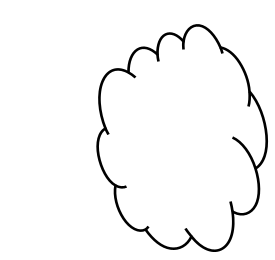We all see many things around us. They all have some mass and weight. In each and every body, there’s a point at which the whole mass of the body can be considered concentrated. In this way, we assume that there is a point inside a body which is considered a balancing point, so that all forces get balanced by it. If we remove all other parts of the body except that point, even all the external forces and all measures of the body will remain the same.
When we talk about ‘Centre of Mass’, it is a part that represents the whole body itself. It lies somewhere in the core of a body; it is Centre of all particles of the body. For example, let us assume a potato which has no specific shape. Suppose, there are 2 external forces acting on this potato. Inside this potato, there is a point C at which the whole mass of potato is centralized. So, even if we remove all the parts of the potato except the point C, those acting external forces, the centre, everything will still remain the same. Basically, a point that represents the whole potato is alone capable of representing the whole potato in the same way as the potato used to do, this point is the Centre of mass.

Sometimes, we hold the pencil on our one fingertip when it is in parallel with the ground, we hold the pencil at a point which is its ‘Centre of mass’.
Difference between ‘Centre of Mass’ and ‘Centre of Gravity’
A Centre of mass is the point in the body, where the whole mass of the body is centralised or concentrated as per our assumption.

here R is ‘Centre of Mass’, M is the whole mass of the body. 𝑚𝑖
is the mass and 𝑟𝑖
is the position vector of any particle.
A Centre of gravity is the point in the body, where the whole weight of the body is centralized or concentrated as per our assumption.

Here R is ‘Centre of gravity’, W is the whole weight of the body. 𝑊𝑖
is the weight and 𝑟𝑖
is the position vector of any particle.
In both cases, we see that both are called the centres of the body. They might be the same points or they might be congruent with each other various times but they are different. We can easily understand that the ‘Centre of mass’ of the body will always be the same always at all places because it represents the mass, the material used in the body which is not going to change, so this point will be the same. On the other hand, the ‘Centre of gravity’ can be different at various places because the gravity changes from place to place. Gravity is less at the equator and gravity increases as we go towards the poles from the equator. So, the Centre of gravity of the same object can be at point A on the equator and the same will be at point B on the polar region for the very same object. But the Centre of mass will be the same at all places because there will be no changes regarding the material used in the body.
There are many factors that affect the gravity on earth. The rotation of earth changes the value of gravity because earth is not a real sphere, it is an irregular ellipsoid. If earth stops rotating, the value of gravity will be the same everywhere.
Also, another factor is height and depth, if we move above earth up to a significant height, the value of gravity starts decreasing. Similarly, if we go deep down in earth, the gravity again starts decreasing. You must know that the gravity is zero at the Centre of earth, so if you try to find out the Centre of gravity at the central point of earth, you will find no point at all, because the gravity doesn’t exist there.
Conclusion
To put this all in a nutshell, we see that the Centre of mass is the point where all the mass of the body can be considered concentrated at one point. It never changes unless the body is cut down or damaged in a way that it loses some of its mass, or in another case if the mass is increased somehow, only then the Centre of mass can change. It is the one point which holds the body on it and helps moving the body in the required direction while moving. All other points can deviate from their path, but this centralised point controls the body always.
 Profile
Profile Settings
Settings Refer your friends
Refer your friends Sign out
Sign out






